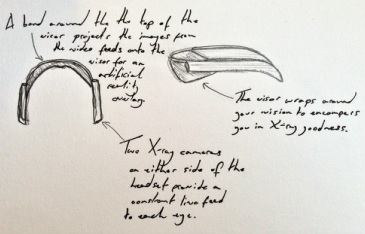
If we choose to work with sight, it only seems sensible to research the part of the body which is responsible for it. The diagram to the right is of the human eye. It is a complex part of the body and the way that it works is very clever. Light enters through the pupil, the dark dot in the middle in the middle of the eye. How much light is let through gets determined by the pupil, which is controlled by the iris. The iris causes the pupil to contract or dilate depending on the intensity of the light. Intense light will cause the pupil to contract, and vice versa.
Light is directed through the pupil by the cornea. It is then focused using the lens and aimed towards retina at the back of the eye. The lens sharpens the image for the centre of the retina as this is where the most cone cells are located. This is where get even smarter. The retina consists of two types of cells; cone cells and rod cells. The cone cells are densely packed into the centre of the retina and cause the high resolution colourful image that our sense of sight provides during bright daylight. They pick up on the things that we are directly looking at. The rod cells are slightly different. They sit around the outer areas of the retina and catch hold of light that lands further away from the centre. This is what causes our peripheral vision. They are lower resolution, but better at picking up light. Hence they are most useful during the dark, when our pupils dilate and allow more light to hit the outer areas of the retina, the rod cells. They also responsible for detecting movement too, and help us with our coordination.
Light is directed through the pupil by the cornea. It is then focused using the lens and aimed towards retina at the back of the eye. The lens sharpens the image for the centre of the retina as this is where the most cone cells are located. This is where get even smarter. The retina consists of two types of cells; cone cells and rod cells. The cone cells are densely packed into the centre of the retina and cause the high resolution colourful image that our sense of sight provides during bright daylight. They pick up on the things that we are directly looking at. The rod cells are slightly different. They sit around the outer areas of the retina and catch hold of light that lands further away from the centre. This is what causes our peripheral vision. They are lower resolution, but better at picking up light. Hence they are most useful during the dark, when our pupils dilate and allow more light to hit the outer areas of the retina, the rod cells. They also responsible for detecting movement too, and help us with our coordination.

The reason we can't see X-rays naturally is because the cells on the retina aren't tuned in to see them. They are only capable of picking up on the visible light spectrum, ie the colours we see around us. The cells then convert the light into electrical signals which get sent to the brain to be interpreted. But what if we could visualise the X-ray spectrum in a way that our brains could understand? We do it in hosptials using cameras to show us still pictures, but if we could create a live X-ray video feed then we could see whatever we looked at in glorious X-ray vision!!
 RSS Feed
RSS Feed